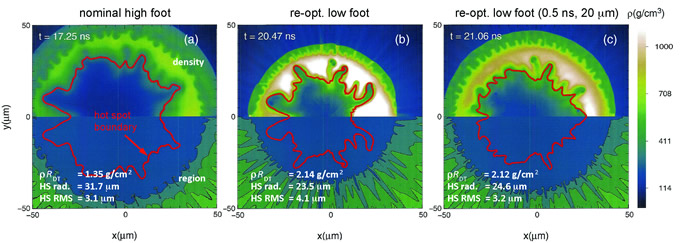Papers and Presentations - 2015
May
Taming NIF Stagnation-Phase Instabilities
LLNL researchers have proposed a new technique for controlling the growth of hydrodynamic instabilities at the interface between the deuterium-tritium (DT) ice and gas in the later “stagnation” (deceleration) stages of NIF cryogenic implosions. The strategy is described in a Physics of Plasmas article published online on May 14.
In the article, Dan Clark and LLNL colleagues Harry Robey and Vladimir Smalyuk describe modifications to the timing of the laser shocks and thickness of the DT ice layer that are calculated to improve the stability of the DT ice-gas interface during the deceleration phase of NIF implosions.
Recent experiments using a “high-foot” (high initial laser pulse) have been successful in controlling implosion stability at the ablation front—but at the cost of reducing the fuel compression that also is needed to attain ignition conditions.
In addition to ablation-front instability, however, instability during the stagnation phase also can interfere with ignition. If the perturbation growth during deceleration is sufficiently large, the increased cooling at the hot spot-cold fuel boundary and subsequent hot spot mass gain will prevent the hot spot from reaching ignition temperatures and result in a quenching of the ignition process.
 Comparison of simulations for the nominal high-foot implosion (a), a “re-optimized” low-foot implosion with a slightly modified pulse shape (b), and the re-optimized low-foot with 20-micron-thicker fuel and 0.5-nanosecond increase in foot duration (c). The red contour indicates the notional hot spot boundary. Comparing (a) to (b), the comparatively lower convergence and low compression of the high-foot case is apparent, as is the higher hot-spot perturbation fraction in the low-foot case. Panel (c) roughly combines the best properties of both implosions: high convergence and compression with relatively small hot-spot perturbations. The improved hot-spot quality comparing (b) to (c) is clear.
Comparison of simulations for the nominal high-foot implosion (a), a “re-optimized” low-foot implosion with a slightly modified pulse shape (b), and the re-optimized low-foot with 20-micron-thicker fuel and 0.5-nanosecond increase in foot duration (c). The red contour indicates the notional hot spot boundary. Comparing (a) to (b), the comparatively lower convergence and low compression of the high-foot case is apparent, as is the higher hot-spot perturbation fraction in the low-foot case. Panel (c) roughly combines the best properties of both implosions: high convergence and compression with relatively small hot-spot perturbations. The improved hot-spot quality comparing (b) to (c) is clear. The proposed new strategy aims to reduce deceleration phase instability growth in NIF ignition implosions without compromising the overall fuel compression. Slightly “mistiming” the shocks driving an implosion, so that the first and second shocks overtake just inside the DT ice-gas boundary, while simultaneously thickening the DT ice layer by 20 microns, appear to lead to an implosion with reduced hot-spot perturbations but without sacrificing the imploded fuel areal density.
The researchers said two-dimensional radiation hydrodynamics simulations indicate that “convergence ratios and fuel areal densities equal to the original low-foot implosion are realizable but with hot-spot perturbation fractions similar to the high foot,” showing that improved stagnation phase stability should be possible without compromising compression.
The technique, however, also results in a reduction in implosion velocity, another critical parameter for achieving ignition. “If improved hohlraum designs aimed at driving higher velocity implosions can be successfully demonstrated on NIF,” the researchers said, “and the final hurdle to achieving ignition proves to be deceleration phase instability growth, then a scheme such as that described here may be crucial to finally reaching ignition conditions on NIF.”




